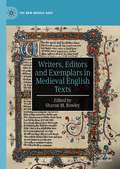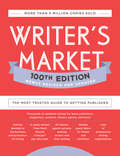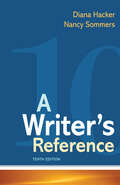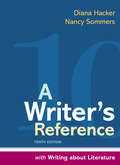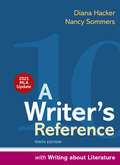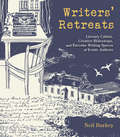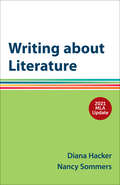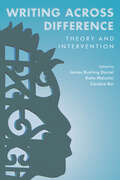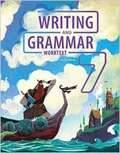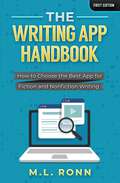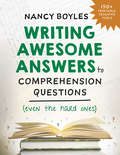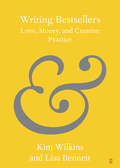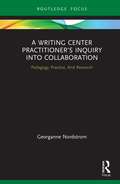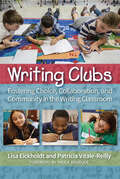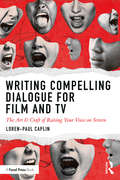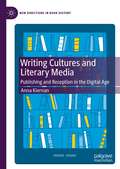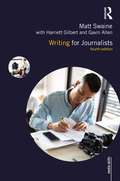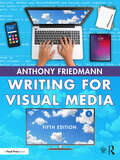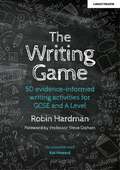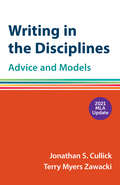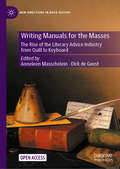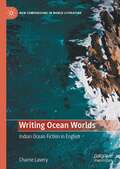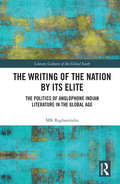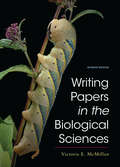- Table View
- List View
Writers, Editors and Exemplars in Medieval English Texts (The New Middle Ages)
by Sharon M. RowleyThis collection of essays explores the literary legacy of medieval England by examining the writers, editors and exemplars of medieval English texts. In order to better understand the human agency, creativity and forms of sanctity of medieval England, these essays investigate both the production of medieval texts and the people whose hands and minds created, altered and/or published them. The chapters consider the writings of major authors such as Chaucer, Gower and Wyclif in relation to texts, authors and ideals less well-known today, and in light of the translation and interpretive reproduction of the Bible in Middle English. The essays make some texts available for the first time in print, and examine the roles of historical scholars in the construction of medieval English literature and textual cultures. By doing so, this collection investigates what it means to recover, study and represent some of the key medieval English texts that continue to influence us today.
Writer's Market 100th Edition: The Most Trusted Guide to Getting Published
by edited by Robert Lee BrewerThe most trusted guide to getting published, fully revised and updatedWant to get published and paid for your writing? Let Writer's Market, 100th edition guide you through the process. It's the ultimate reference with thousands of publishing opportunities for writers, listings for book publishers, consumer and trade magazines, contests and awards, and literary agents—as well as new playwriting and screenwriting sections, along with contact and submission information. Beyond the listings, you'll find articles devoted to the business and promotion of writing. Discover 20 literary agents actively seeking writers and their writing, how to develop an author brand, and overlooked funds for writers. This 100th edition also includes the ever-popular pay-rate chart and book publisher subject index.You'll gain access to: • Thousands of updated listings for book publishers, magazines, contests, and literary agents • Articles devoted to the business and promotion of writing • A newly revised "How Much Should I Charge?" pay rate chart • Sample query letters for fiction and nonfiction • Lists of professional writing organizations
A Writer's Reference
by Diana Hacker Nancy SommersEngage more. Achieve more.A Writer’s Reference helps you engage in and meet the challenges of your writing course. Clear How-to boxes help you complete common writing assignments like argument and analysis. Guidance about paraphrasing and fact-checking sources help you become a more responsible writer and reader. And Notes-to-self help you reflect on your progress and plan your revision. If your instructor has assigned Achieve, you have new ways to engage with course material and with your instructor and peers. Revision planning tools and individualized study plans help you become a better writer, and a built-in e-book puts your problem and your solution side by side.
A Writer’s Reference with Writing about Literature
by Diana Hacker Nancy SommersWriting about Literature is a practical guide to interpreting works of literature and to planning, composing, and documenting papers about literature. Students will find help with forming and supporting an interpretation, avoiding plot summary, integrating quotations from a literary work, observing the conventions of literature papers, and using secondary sources. Writing about Literature also includes two sample student essays — one that uses only a primary source and one that uses primary and secondary sources.
A Writer's Reference with Writing about Literature, with 2021 MLA Update: A Hacker Handbooks Supplement
by Diana Hacker Nancy SommersThis ebook has been updated to provide you with the latest guidance on documenting sources in MLA style and follows the guidelines set forth in the MLA Handbook, 9th edition (April 2021).Writer's Reference with Writing about Literature, is a practical guide to interpreting works of literature and to planning, composing, and documenting papers about literature. Students will find help with forming and supporting an interpretation, avoiding plot summary, integrating quotations from a literary work, observing the conventions of literature papers, and using secondary sources. Writer's Reference with Writing about Literature also includes two sample student essays — one that uses only a primary source and one that uses primary and secondary sources.
Writers' Retreats: Literary Cabins, Creative Hideaways, and Favorite Writing Spaces of Iconic Authors
by Neil BurkeyFeaturing over 50 writers and their getaways--get a glimpse into the creative habits of some of the greatest writers of the last two centuries. From Henry David Thoreau's famous cabin at Walden Pond and James Baldwin's 'Welcome Table' in Provence, to Roald Dahl's garden hut and Toni Morrison's sunrise-lit couch at dawn, Writers' Retreats reveals the quirky, private, and sometimes curious places where literary magic has happened. Each location is brought to life through illustration and the writer's own words on what made that place so perfect for creating.An exploration of famous literary writers of past and present, from Emily Dickinson and Marcel Proust to Margaret Atwood, Chimamanda Ngozi Adichie, and Alice Munro, this is the perfect bookish gift for both writers and booklovers to feed their fascination with what ignited the creativity behind their favorite works of literature.
Writing about Literature with 2021 MLA Update: A Hacker Handbooks Supplement
by Diana Hacker Nancy SommersThis ebook has been updated to provide you with the latest guidance on documenting sources in MLA style and follows the guidelines set forth in the MLA Handbook, 9th edition (April 2021).Writing about Literature is a practical guide to interpreting works of literature and to planning, composing, and documenting papers about literature. Students will find help with forming and supporting an interpretation, avoiding plot summary, integrating quotations from a literary work, observing the conventions of literature papers, and using secondary sources. Writing about Literature also includes two sample student essays — one that uses only a primary source and one that uses primary and secondary sources.
Writing Across Difference: Theory and Intervention
by James Rushing Daniel Katie Malcolm Candice RaiAs the nation becomes increasingly divided by economic inequality, racial injustice, xenophobic violence, and authoritarian governance, scholars in writing studies have strived to develop responsive theories and practices to engage students, teachers, administrators, and citizens in the crisis of division and to begin the complicated work of radically transforming our inequitable institutions and society. Writing Across Difference is one of the first collections to gather scholars from across the field engaged in offering theoretical, methodological, and pedagogical resources for understanding, interrogating, negotiating, and writing across difference. No text in composition has made such a sweeping attempt to place the multiple areas of translingualism, anti-racism, anticolonialism, interdisciplinarity, and disability into conversation or to represent the field as broadly unified around the concept of difference. The chapters in this book specifically explore how monolingual ideology is maintained in institutions and how translingual strategies can (re)include difference; how narrative-based interventions can promote writing across difference in classrooms and institutions by complicating dominant discourses; and how challenging dominant logics of class, race, ability, and disciplinarity can present opportunities for countering divisiveness. Writing Across Difference offers writing scholars a sustained intellectual encounter with the crisis of difference and foregrounds the possibilities such an encounter offers for collective action toward a more inclusive and equitable society. It presents a variety of approaches for intervening in classrooms and institutions in the interest of focalizing, understanding, negotiating, and bridging difference. The book will be a valuable resource to those disturbed by the bigotry, violence, and fanaticism that mark our political culture and who are seeking inspiration, models, and methods for collective response. Contributors: Anis Bawarshi, Jonathan Benda, Megan Callow, James Rushing Daniel, Cherice Escobar Jones, Laura Gonzales, Juan Guerra, Stephanie Kerschbaum, Katie Malcolm, Nadya Pittendrigh, Mya Poe, Candice Rai, Iris Ruiz, Ann Shivers-McNair, Neil Simpkins, Alison Y. L. Stephens, Sumyat Thu, Katherine Xue, Shui-yin Sharon Yam
Writing and Grammar Worktext
by Joaquim C. Remelgado MA Kristin Villalba MatThe contents of Writing and Grammar Worktext, Fourth Edition, include Sentences, Verbs, Nouns, Pronouns, Narrative Writing, Adjectives, Adverbs, Phrases, Informative Writing, Clauses, Verbals, Subject-Verb Agreement, Pronoun-Antecedent Agreement, Argumentative Writing, Pronoun Usage, Punctuation, Capitalization, Writing Project: Creating an Article.
The Writing App Handbook: How to Choose the Best App for Fiction and Nonfiction Writing (Author Level Up #11)
by M.L. RonnHow's your writing app working out for you lately? If you're reading this, then you're dissatisfied with your current writing software and want something better. After all, your time is too valuable to waste fighting with an app that doesn't love you back. The RIGHT writing app will make you twice as productive and help you write more books in less time. You’ll be able to write more books than you ever dreamed of. In this guide, prolific author M.L. Ronn will cover the top features of the hottest writing apps on the market to help you choose the best fit for your writer personality. You'll discover: How the right writing app can boost your word counts and reduce typos in your books How to avoid wasting money on the wrong writing app (buy it nice or buy it twice!!) Apps that are better than OpenOffice, MS Word, and Google Docs: 100% guaranteed 35+ helpful features that writers are using to crush their novels A free tool that can help you pick the best writing app in a few clicks Don't settle for the wrong fit. Buy the Writing App Handbook to meet your perfect writing app today! V1.0
Writing Awesome Answers to Comprehension Questions (Even the Hard Ones)
by Nancy BoylesHelp students appreciate texts and write about them with conviction. Responding to a comprehension question is a surprisingly complex task. It draws on multiple skills: students must be able to read and analyze a text passage; consider what aspect of the text the question addresses; and then quickly and concisely write about their ideas, citing evidence to support them. Hence the prominence of constructed-response questions in standardized testing. In this refreshingly clear and upbeat guide, literacy consultant Nancy Boyles gives a step-by-step demonstration of how to help students achieve success with this task—and in the process of unpacking the steps involved, demonstrates how the instruction can inspire teachers’ creativity as well as deepen students’ literacy skills. Filled with ready-to-use scaffolds for every stage of instruction—sets of sample questions, anchor charts, cue cards, answer frames—this is a one-stop resource for teaching students how to organize their thoughts about what they’ve read, and then set them down in writing.
Writing Bestsellers: Love, Money and Creative Practice (Elements in Publishing and Book Culture)
by Kim Wilkins Lisa BennettWhile the term 'bestseller' explicitly relates books to sales, commercially successful books are also products of individual creative work. This Element presents a new perspective on the relationship between art and the market, with particular reference to bestselling writers and books. We examine some existing perspectives on art's relationship to the marketplace to trouble persistent binaries that see the two in opposition; we break down the monolith of the marketplace by thinking of it as made up of a range of invested, non-hostile participants such as publishing personnel and readers; we articulate the material dimensions of creative writing in the industry through the words of bestselling writers themselves; and we examine how the existence of bestselling books and writers in the world of letters bears enormous influence on the industry, and on the practice of other writers.
A Writing Center Practitioner's Inquiry into Collaboration: Pedagogy, Practice, And Research (Routledge Research in Writing Studies)
by Georganne NordstromThis book presents a model of Practitioner Inquiry (PI) as a systematic form of empirical research and provides a rationale for its suitability within a writing center context. Exploring the potential of writing centers as pedagogical sites that support research, the book offers an accessible model that guides both research and practice for writing center practitioners, while offering flexibility to account for their distinct contexts of practice. Responding to the increasing call in the field to produce empirical “RAD” (replicable, aggregable, data-driven) research, the author explores Practitioner Inquiry through explication of methodology and methods, a revisitation of collaboration to guide both practice and research, and examples of application of the model. Nordstrom grounds this research and scholarship in Hawaiʻi’s context and explores Indigenous concepts and approaches to inform an ethical collaborative practice. Offering significant contributions to empirical research in the fields of writing center studies, composition, and education, this book will be of great relevance to writing center practitioners, anyone conducting empirical research, and researchers working in tutor professionalization, collaboration, translingual literacy practices, and researchmethodologies.
Writing Clubs: Fostering Community, Collaboration, and Choice in the Writing Classroom
by Lisa Eickholdt Patricia Vitale-ReillyAsk teachers about their biggest challenges in elementary and middle school, and many will say the teaching of writing. It is often difficult for students find the joy, discovery, and satisfaction writing can yield. What Lisa Eickholdt and Patricia Vitale-Reilly have found is that adherence to genre studies can get in the way of student collaboration. Believing writing instruction should be more authentic, they want students to have more choices, develop better collaboration, and sustain a sense of community, all through the implementation of writing clubs.In their book Writing Clubs: Fostering Choice, Collaboration, and Community in the Writing Classroom , you'll discover ways to: Collaborate throughout the process of writing Choose what to write and how to write it Examine mentor texts and study craft techniques across genres Develop speaking and listening skills Celebrate classmates&’ accomplishments through publication Collaboration is widely recognized as a vital life skill. Eickholdt and Vitale-Reilly present a plethora of ideas on how gratifying it can be right now, as well as in the future. There&’s an old proverb that says, &‘If you want to go fast, go alone. If you want to go far, go with others.&’ In Writing Clubs , we discover that there is no limit to how far young writers can go when teachers show them what it means to collaborate.
Writing Compelling Dialogue for Film and TV: The Art & Craft of Raising Your Voice on Screen
by Loren-Paul CaplinWriting Compelling Dialogue for Film and TV is a practical guide that provides you, the screenwriter, with a clear set of exercises, tools, and methods to raise your ability to hear and discern conversation at a more complex level, in turn allowing you to create better, more nuanced, complex and compelling dialogue. The process of understanding dialogue writing begins with increasing writers’ awareness of what they hear. This book provides writers with an assortment of dialogue and language tools, techniques, and exercises and teaches them how to perceive and understand the function, intent and thematic/psychological elements that dialogue can convey about character, tone, and story. Text, subtext, voice, conflict, exposition, rhythm and style are among the many aspects covered. This book reminds us of the sheer joy of great dialogue and will change and enhance the way writers hear, listen to, and write dialogue, and along the way aid the writers’ confidence in their own voice allowing them to become more proficient writers of dialogue. Written by veteran screenwriter, playwright, and screenwriting professor Loren-Paul Caplin, Writing Compelling Dialogue is an invaluable writing tool for any aspiring screenwriter who wants to improve their ability to write dialogue for film and television, as well as students, professionals, and educators.
Writing Cultures and Literary Media: Publishing and Reception in the Digital Age (New Directions in Book History)
by Anna KiernanThis Pivot investigates the impact of the digital on literary culture through the analysis of selected marketing narratives, social media stories, and reading communities. Drawing on the work of contemporary writers, from Bernardine Evaristo to Patricia Lockwood, each chapter addresses a specific tension arising from the overarching question: How has writing culture changed in this digital age? By examining shifting modes of literary production, this book considers how discourses of writing and publishing and hierarchies of cultural capital circulate in a socially motivated post-digital environment. Writing Cultures and Literary Media combines compelling accounts of book trends, reader reception, and interviews with writers and publishers to reveal fresh insights for students, practitioners, and scholars of writing, publishing, and communications.
Writing for Journalists (Media Skills)
by Matt Swaine Harriett Gilbert Gavin AllenThoroughly revised and updated, the fourth edition of Writing for Journalists focuses on the craft of journalistic writing, offering invaluable insight on how to hook readers and keep them to the end of your article. The book offers a systematic approach to news and feature writing that starts with the basics and builds to more complex and longer pieces. The authors give the reader the tools they need to deliver engaging and authoritative writing that works across print and digital. Drawing on professional insight from writers across the industry, the book guides readers through the essential elements needed to write powerful and effective news stories, from hard news pieces to features on business, science, travel and entertainment reviews. New to this edition are hands-on writing exercises accompanying each chapter to help reinforce key points; chapters on how to build a professional profile, pitch stories and get commissioned; and a section on online writing, SEO, analytics and writing for social media. This is an essential guide for all journalism students and early-career journalists. It also has much to offer established journalists looking to develop their writing and lead editorial teams.
Writing for Visual Media
by Anthony FriedmannWriting for Visual Media provides writers with an understanding of the nature of visual writing behind all visual media. Such writing is vital for directors, actors, and producers to communicate content to audiences. Friedmann provides an extended investigation into dramatic theory and how entertainment narrative works, illustrated by examples and detailed analysis of scenes, scripts, techniques, and storylines. This new edition has a finger on the pulse of the rapidly evolving media ecosystem and explains it in the context of writing and creating content. Friedmann lays out many of the complex professional, creative, and commercial issues that a writer needs to understand in order to tell engaging stories and construct effective and professional screenplays. This new edition includes: A new chapter on storytelling A fresh examination of dramatic theory and how to apply it to constructing screenplays Updated discussion of mobile platforms A lengthened discussion of copyright, ethics, and professional development issues An updated companion website with sample scripts and corresponding videos, an interactive glossary, sample storyboards and screenplays, links to industry resources, and materials for instructors such as slides, a syllabus, and a test bank.
The Writing Game: 50 Evidence-Informed Writing Activities for GCSE and A Level
by Robin HardmanAs every humanities or social science teacher knows, success in exam years relies on pupils’ ability to blend subject knowledge with writing skills. But teachers face two significant problems in developing writing in their classroom: many pupils regard writing practice as a chore or a punishment; and research on writing instruction remains difficult for busy teachers to access. The Writing Game: 50 Evidence-Informed Writing Activities for GCSE and A Level aims to solve these problems by providing a must-read practical toolkit for teachers looking to help their pupils to write their way into the top grades, offering a menu of engaging lesson activities that can be modified to suit any subject context. With activities covering modelling, practice, and feedback, The Writing Game supports teachers to deliver research-informed strategies at every stage of the learning process. Perfect for teachers, middle leaders, and senior leaders, The Writing Game also contains tips on how to incorporate writing practice into regular subject content, formative assessment, and retrieval practice. Each activity is fully explained and accompanied by top tips for maximising effective learning, suggested adaptations, and links to appropriate research. Activities range from rapid five-minute starters and plenaries to whole-lesson extended writing tasks, with plenty in between, and busy teachers will be relieved to hear that many require very little preparation.
The Writing Game: 50 Evidence-Informed Writing Activities for GCSE and A Level
by Robin HardmanAs every humanities or social science teacher knows, success in exam years relies on pupils’ ability to blend subject knowledge with writing skills. But teachers face two significant problems in developing writing in their classroom: many pupils regard writing practice as a chore or a punishment; and research on writing instruction remains difficult for busy teachers to access. The Writing Game: 50 Evidence-Informed Writing Activities for GCSE and A Level aims to solve these problems by providing a must-read practical toolkit for teachers looking to help their pupils to write their way into the top grades, offering a menu of engaging lesson activities that can be modified to suit any subject context. With activities covering modelling, practice, and feedback, The Writing Game supports teachers to deliver research-informed strategies at every stage of the learning process. Perfect for teachers, middle leaders, and senior leaders, The Writing Game also contains tips on how to incorporate writing practice into regular subject content, formative assessment, and retrieval practice. Each activity is fully explained and accompanied by top tips for maximising effective learning, suggested adaptations, and links to appropriate research. Activities range from rapid five-minute starters and plenaries to whole-lesson extended writing tasks, with plenty in between, and busy teachers will be relieved to hear that many require very little preparation.
Writing in the Disciplines with 2021 MLA Update: A Hacker Handbooks Supplement
by Diana Hacker Nancy Sommers Jonathan S. Cullick Terry Myers ZawackiThis ebook has been updated to provide you with the latest guidance on documenting sources in MLA style and follows the guidelines set forth in the MLA Handbook, 9th edition (April 2021).With practical advice and plenty of student models, Writing in the Disciplines provides a jump start for writing college papers in nine disciplines — biology, business, criminal justice/criminology, education, engineering, history, music, nursing, and psychology. Each discipline section features information on audience expectations in that area of study, the types of questions asked, the types of documents produced, the kinds of evidence used, appropriate language conventions, and appropriate citation styles. Each section features a model student paper (two in business) written in response to a typical assignment in the discipline. Advice for writing in business, criminal justice, education, nursing, and psychology includes updated APA guidelines (2020).
Writing Manuals for the Masses: The Rise of the Literary Advice Industry from Quill to Keyboard (New Directions in Book History)
by Anneleen Masschelein Dirk De GeestThis open access collection of essays examines the literary advice industry since its emergence in Anglo-American literary culture in the mid-nineteenth century within the context of the professionalization of the literary field and the continued debate on creative writing as art and craft. Often dismissed as commercial and stereotypical by authors and specialists alike, literary advice has nonetheless remained a flourishing business, embodying the unquestioned values of a literary system, but also functioning as a sign of a literary system in transition. Exploring the rise of new online amateur writing cultures in the twenty-first century, this collection of essays considers how literary advice proliferates globally, leading to new forms and genres.
Writing Ocean Worlds: Indian Ocean Fiction in English (New Comparisons in World Literature)
by Charne LaveryThis book explores the Indian Ocean world as it is produced by colonial and postcolonial fiction in English. It analyses the work of three contemporary authors who write the Indian Ocean as a region and world—Amitav Ghosh, Abdulrazak Gurnah, and Lindsey Collen—alongside maritime-imperial precursor Joseph Conrad. If postcolonial literatures are sometimes read as national allegories, this book presents an account of a different and significant strand of postcolonial fiction whose geography, in contrast, is coastal and transoceanic. This work imaginatively links east Africa, south Asia and the Arab world via a network of south-south connections that precedes and survives European imperialism. The novels and stories provide a vivid, storied sense of place on both a local and an oceanic scale, and in so doing remap the world as having its centre in the ocean and the south.
The Writing of the Nation by Its Elite: The Politics of Anglophone Indian Literature in the Global Age (Literary Cultures of the Global South)
by MK RaghavendraThis volume examines the idea of India as it emerges in the writing of its anglophone elite, post-2000. Drawing on a variety of genres, including fiction, histories, non-fiction assessments – economic, political, and business – travel accounts, and so on, this book maps the explosion of English-language writing in India after the economic liberalization and points to the nation’s sense of its growing importance as a producer of culture. From Ramachandra Guha to William Dalrymple, from Arundhati Roy to Pankaj Mishra, from Jhumpa Lahiri to Amitav Ghosh, from Amartya Sen to Gurcharan Das, from Barkha Dutt to Tarun Tejpal, this investigation takes us from aesthetic imaginings of the nation to its fractured political fault lines, the ideological predispositions of the writers often pointing to an asymmetrically constituted India. A major intervention on how postcolonial India is written about and imagined in the anglophone world, this book will be of great interest to scholars and researchers of cultural studies, literature, history, and South Asian studies. It will also be of interest to general readers with an inclination towards India and Indian writing.
Writing Papers in the Biological Sciences
by Victoria E. McMillanWritten by a professional biologist and experienced writing teacher, this comprehensive guide for students provides detailed instruction on researching, drafting, revising, and documenting lab reports, research papers, reviews, poster presentations, and other commonly assigned projects in biology courses. The seventh edition features updated coverage of research methods and new student examples from a wider variety of sub-disciplines in biology that support students at all levels of biology.
